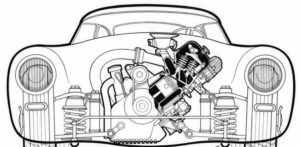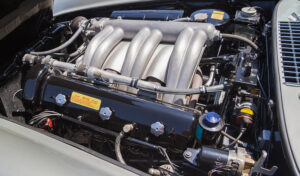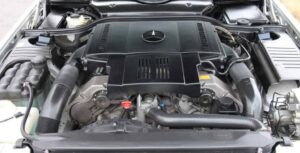The evolution of the Mercedes 300SL engine
1. The evolution of the Mercedes 300SL engine: A legacy of innovation
2. The original 300SL engine: Powering the W194
3. The W198 300SL gullwing: A leap in technology
4. The R107 300SL: The M103 engine returns
5. The R129 300SL: The final chapter
6. Preserving the legacy of the 300SL engine
The evolution of the Mercedes 300SL engine: A legacy of innovation
The Mercedes-Benz 300SL engine is a key factor behind the iconic reputation of the SL insignia. Known for its groundbreaking engineering and design, the 300SL engine powered both competition victories and luxury road cars, contributing to the global recognition of the Mercedes brand. This article traces the development of the 300SL engine across its different iterations, showcasing the technological advancements that made it a leader in performance and design.
The original 300SL engine: Powering the W194
The story of the 300SL engine begins in 1951 with the introduction of the W194 racing car. Under the hood, the engine was a modified version of the M186, originally from the 300S tourer. Engineers reworked this 3.0-liter SOHC straight-six engine, redesignating it as the M194. Key improvements included a triple-barrel Solex carburetor setup and a diagonal placement of the engine at a 50-degree angle, allowing for larger intake and exhaust valves. These modifications enabled the M194 to produce 175 horsepower and 207 N-M (153 lb-ft) of torque, giving the W194 a top speed of 160 mph.
This innovative engine layout, mounted at a steep angle, was a hallmark of the W194’s design, which contributed to its success in the motorsport world, including a famous win in the Carrera Panamericana. The W194’s triumphs on the track set the stage for the next evolution of the 300SL engine.
The W198 300SL gullwing: A leap in technology
In 1954, Mercedes-Benz introduced the 300SL Gullwing, a road-going version of the W194. This vehicle was equipped with a new engine, the M198, which represented a significant leap forward in engineering. This 3.0-liter water-cooled straight-six featured Bosch fuel injection, a major upgrade from the carbureted system used in the W194. The aluminium head was positioned at a 30-degree angle to allow room for even larger valves, improving airflow and overall performance.
The M198 engine also incorporated a dry sump lubrication system, ensuring better oil distribution during high-speed cornering. This feature made the Gullwing a serious contender for performance enthusiasts. For drivers seeking even more power, Mercedes offered a free optional sports camshaft with a compression ratio of 9.5:1, further enhancing the car’s capabilities.
With an output of 240 horsepower and 294 N-M (217 lb-ft) of torque, the Gullwing was a technological marvel for its time. Its powerful engine and advanced engineering made it one of the most desirable sports cars of the 1950s.
The R107 300SL: The M103 engine returns
After a long hiatus, the 300SL name returned in 1985 with the R107 model, featuring the M103 engine. This 3.0-liter inline-six engine used a SOHC configuration with two valves per cylinder and a wet sump lubrication system. While the M103 was less performance-oriented than its predecessors, it was a reliable and well-engineered power plant. The engine produced a respectable 185 horsepower and 260 N-M (192 lb-ft) of torque.
The R107’s 300SL, equipped with the M103, was a roadster built for comfort and style, rather than outright speed. However, its relatively lightweight design made it an excellent candidate for performance modifications, which remains a popular choice among enthusiasts to this day.
The R129 300SL: The final chapter
The next significant chapter for the 300SL engine came in 1989 with the introduction of the R129 model. Initially, the R129 continued to use the same M103 engine as the R107, but in 1990, Mercedes introduced a more advanced version: the 300SL-24, powered by the M104 engine. This 3.0-liter DOHC inline-six featured 24 valves, four per cylinder, and produced 228 horsepower. Other advancements included KE-Jetronic fuel injection, variable valve timing, and under-piston cooling jets, ensuring optimal performance and reliability.
The M104 engine offered a significant performance boost over the M103, allowing Mercedes-Benz to market the 300SL at a premium price. The advanced engineering of the M104 helped the R129 300SL maintain its reputation for luxury, innovation, and performance until production ceased in 1993.
Preserving the legacy of the 300SL engine
The 300SL engine, in its various forms, is a symbol of engineering excellence that helped elevate the Mercedes-Benz brand to international prominence. From the race-winning W194 to the luxurious R129, each iteration of the 300SL engine pushed the boundaries of performance and design.
Preserving the integrity of these engines is essential for maintaining the value and performance of the 300SL. For owners of these classic vehicles, regular maintenance and expert restoration are key to ensuring the longevity of their engines. Whether it’s the M103 or the M104, proper care and attention to detail can keep these iconic engines running smoothly for years to come.
In conclusion, the evolution of the 300SL engine reflects Mercedes-Benz’s dedication to innovation, quality, and performance. Each generation of the 300SL left a lasting mark on the automotive world, solidifying the SL insignia’s place in history as a symbol of excellence.
Are you already a proud owner of a Mercedes R129 SL? If so, check out our selection of parts for this car at the following link: https://octoclassic.com/product-category/mercedes-benz/r129
https://octoclassic.com/product-category/mercedes-benz
Photos sources: theslshop.com, pixels.com











